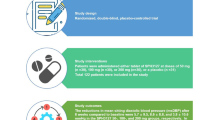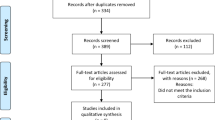Abstract
Medicinal plants are widely used as a first-line therapy for hypertension, often without comparative clinical data. A prospective, randomized controlled trial was conducted to assess efficacy of Combretum micranthum (kinkeliba) and Hibiscus sabdariffa (bissap), in the galenic form of capsules of plant powder, on blood pressure in adult patients with non-complicated hypertension ( > 140/90 mm Hg). One hundred and twenty five patients were randomly allocated into group 1 (kinkeliba leaves 190 mg × 2/day), or group 2 (bissap calyx 320 mg × 2/day), or group 3 (ramipril 5 mg /day) during four consecutive weeks. Blood and urinary samples were collected on day 0 and 28 while patients’ blood pressure was measured weekly. In all three groups SBP and DBP decreased over 3 weeks of treatment (P < 0.001). For SBP, mean decrease was higher with ramipril (−16.7 ± 8.4 mm Hg) than with kinkeliba (−12.2 ± 6.6 mm Hg, P = 0.016) and bissap (−11.2 ± 3.3 mm Hg, P = 0.001). For DBP, mean decrease with ramipril (−6.7 ± 3.6 mm Hg) was more important than with kinkeliba (−5.0 ± 3.0 mm Hg, P = 0.011) but not statistically different to bissap group (−6.0 ± 4.7 mm Hg, P = 0.271). A significant natriuretic effect was observed in the kinkeliba and bissap groups but not in patients under ramipril treatment. At the end of the four weeks, 39% [95% CI: 25.7–54.3] of patients in the ramipril group, 37% [95% CI: 23.6–51.9] of patients in the kinkeliba group and 21% [95% CI: 11.7–35.9] of those taking bissap had normalized their BP.
This is a preview of subscription content, access via your institution
Access options
Subscribe to this journal
Receive 12 digital issues and online access to articles
$119.00 per year
only $9.92 per issue
Buy this article
- Purchase on Springer Link
- Instant access to full article PDF
Prices may be subject to local taxes which are calculated during checkout


Similar content being viewed by others
References
Dalal S, Beunza JJ, Volmink J, Adebamowo C, Bajunirwe F, Njelekela M, Mozaffarian D, et al. Non-communicable diseases in sub-Saharan Africa: what we know now. Int J Epidemiol. 2011;40:885–901.
Alwan A, Armstrong T, Cowan M, Riley L. Non-communicable Diseases Country Profiles 2011. Geneva, Switzerland: World Health Organization; 2011.
Alwan A, Maclean DR, Riley LM, d’Espaignet ET, Mathers CD, Stevens GA, et al. Monitoring and surveillance of chronic non-communicable diseases: progress and capacity in high-burden countries. Lancet. 2010;376:1861–8.
Lawes CM, Vander Hoorn S, Rodgers A. (2008) International Society of Hypertension. Global burden of blood-pressure-related disease. Lancet. 2001;371:1513–8.
Abegunde D, Mathers CD, Adam T, Ortegon M, Strong K. The burden and costs of chronic diseases in low-income and middle-income countries. Lancet. 2007;370:1929–38.
Welch CR. Chemistry and pharmacology of kinkéliba (Combretum micranthum), a West African medicinal plant. PhD Thesis, Medicinal Chemistry, New Brunswick-New Jersey, Geneva, US, 2010. pp 268.
World Health Organization Geneva 2013. WHO traditional medicine strategy: 2014–23. http://apps.who.int/iris/bitstream/10665/92455/1/9789241506090_eng.pdf. Accessed 25 Sept 2014.
Serban C, Sahebkar A, Ursoniu S, Andrica F, Banach M. Effect of sour tea (Hibiscus sabdariffa L.) on arterial hypertension: a systematic review and meta-analysis of randomized controlled trials. J Hypertens. 2015;33:1119–27.
Mathieu G, Meissa D. Traditional leafy vegetables in senegal: diversity and medicinal uses. Afr J Tradit Complement Altern Med. 2007;4:469–75.
Mahadevan N, Kamboj S, Kamboj P. Hibiscus sabdariffa Linn.–an overview. Nat Prod Radiance. 2009;8:77–83.
Eloff JN, Katerere DR, McGaw LJ. The biological activity and chemistry of the southern African Combretaceae. J Ethnopharmacol. 2008;119:686–99.
Hopkins AL, Lamm MG, Funk JL, Ritenbaugh C. Hibiscus sabdariffa L. in the treatment of hypertension and hyperlipidemia: a comprehensive review of animal and human studies. Fitoterapia. 2013;85:84–94.
Chrysant SG. The clinical significance and costs of herbs and food supplements used by complementary and alternative medicine for the treatment of cardiovascular diseases and hypertension. J Hum Hypertens. 2016;30:1–6.
European Medicines Agency. Guideline on quality of herbal medicinal products/ traditional herbal medicinal products. http://www.ema.europa.eu/docs/en_GB/document_library/Scientific_guideline/2011/09/WC500113209.pdf. Accessed 26 Sept 2014.
Herrera-Arellano A, Flores-Romero S, Chávez-Soto MA, Tortoriello J. Effectiveness and tolerability of a standardized extract from Hibiscus sabdariffa in patients with mild to moderate hypertension: a controlled and randomized clinical trial. Phytomedicine. 2004;11:375–82.
Herrera-Arellano A, Miranda-Sánchez J, Avila-Castro P, Herrera-Alvarez S, Jiménez-Ferrer JE, Zamilpa A, et al. Clinical effects produced by a standardized herbal medicinal product of Hibiscus sabdariffa on patients with hypertension. A randomized, double-blind, lisinopril-controlled clinical trial. Planta Med. 2007;73:6–12.
McKay DL, Chen CY, Saltzman E, Blumberg JB. Hibiscus sabdariffa L. tea (tisane) lowers blood pressure in prehypertensive and mildly hypertensive adults. J Nutr. 2010;140:298–303.
Mozaffari-Khosravi H, Ahadi Z, Barzegar K. The effect of green tea and sour tea on blood pressure of patients with type 2 diabetes: a randomized clinical trial. J Diet Suppl. 2013;10:105–15.
Mozaffari-Khosravi H, Jalali-Khanabadi BA, Afkhami-Ardekani M, Fatehi F, Noori-Shadkam M. The effects of sour tea (Hibiscus sabdariffa) on hypertension in patients with type II diabetes. J Hum Hypertens. 2009;23:48–54.
Joven J, March I, Espinel E, Fernández-Arroyo S, Rodríguez-Gallego E, Aragonès G, et al. Hibiscus sabdariffa extract lowers blood pressure and improves endothelial function. Mol Nutr Food Res. 2014;58:1374–8.
Jiménez-Ferrer E, Alarcón-Alonso J, Aguilar-Rojas A, Zamilpa A, Jiménez-Ferrer CI, Tortoriello J, et al. Diuretic effect of compounds from Hibiscus sabdariffa by modulation of the aldosterone activity. Planta Med. 2012;78:1893–8.
Ojeda D, Jiménez-Ferrer E, Zamilpa A, Herrera-Arellano A, Tortoriello J, Alvarez L. Inhibition of angiotensin convertin enzyme (ACE) activity by the anthocyanins delphinidin- and cyanidin-3-O-sambubiosides from Hibiscus sabdariffa. J Ethnopharmacol. 2010;127:7–10.
Diallo D, Guissou IP, Haïdara M, Tall C, Kasido OMJ. Recherche sur la médecine traditionnelle Africaine: hypertension. The African Health Monitor. WHO Publication office for Africa; Brazzaville, 2010.
Diatta W, Lo M, Fall AD, Bassene S, Sagna S, Badji K, et al. Popular Traditional Herbal Medicines from the Jóolas of Essyl in the Rural Community of Enampor (Ziguinchor, Sénégal). In: Juliani RH, Simon JE, Chi-Tang H, editors. African natural plant products: new discoveries and challenges in chemistry and quality. Washington D.C: American Chemical Society (ACS) Symposium Series; 2009. p. 111–34.
de Morais Lima GR, de Sales IR, Caldas Filho MR, de Jesus NZ, de Sousa Falcão H, Barbosa-Filho JM, et al. Bioactivities of the genus Combretum (Combretaceae): a review. Molecules. 2012;17:142–206.
Olajide OA, Makinde JM, Okpako DT. Evaluation of the anti-inflammatory property of the extract of Combretum micranthum G. Don (Combretaceae). Inflammopharmacology. 2003;11:293–8.
Touré A, Xu X, Michel T, Bangoura M. In vitro antioxidant and radical scavenging of Guinean kinkeliba leaf (Combretum micranthum G. Don) extracts. Nat Prod Res. 2011;25:1025–36.
Ojewole JA. Cardiovascular effects of mollic acid glucoside, a 1 alpha-hydroxycycloartenoid saponin extractive from Combretum molle R.Br. ex G.Don (Combretaceae) leaf. Cardiovasc J Afr. 2008;19:128–34.
Nsuadi Manga F, El Khattabi C, Fontaine J, Berkenboom G, Duez P, Lami Nzunzu J, et al. Vascular effects and antioxidant activity of two Combretum species from Democratic Republic of Congo. J Ethnopharmacol. 2012; 142:194–200.
Acknowledgements
The patients involved in this study, International Society of Nephrology (ISN), Medical authorities in Senegal, Pharmacie de l’Orangerie and Antenna Technologies, Unité Mixte Internationale ≪ Environnement-Santé-Société ≫ UMI-3189. Gabrial Erismann for English revision of the manuscript.
Author information
Authors and Affiliations
Corresponding author
Ethics declarations
Conflict of interest
The authors declare no conflict of interest.
Rights and permissions
About this article
Cite this article
Seck, S.M., Doupa, D., Dia, D.G. et al. Clinical efficacy of African traditional medicines in hypertension: A randomized controlled trial with Combretum micranthum and Hibiscus sabdariffa. J Hum Hypertens 32, 75–81 (2018). https://doi.org/10.1038/s41371-017-0001-6
Received:
Revised:
Accepted:
Published:
Issue Date:
DOI: https://doi.org/10.1038/s41371-017-0001-6
This article is cited by
-
Hypertension treatment with Combretum micranthum or Hibiscus sabdariffa, as decoction or tablet: a randomized clinical trial
Journal of Human Hypertension (2021)
-
Effects of salt stress on the morphological characteristics, total phenol and total anthocyanin contents of Roselle (Hibiscus sabdariffa L.)
Plant Physiology Reports (2019)
-
Effect of sieved fractionation on the physical, flow and hydration properties of Boscia senegalensis Lam., Dichostachys glomerata Forssk. and Hibiscus sabdariffa L. powders
Food Science and Biotechnology (2019)



